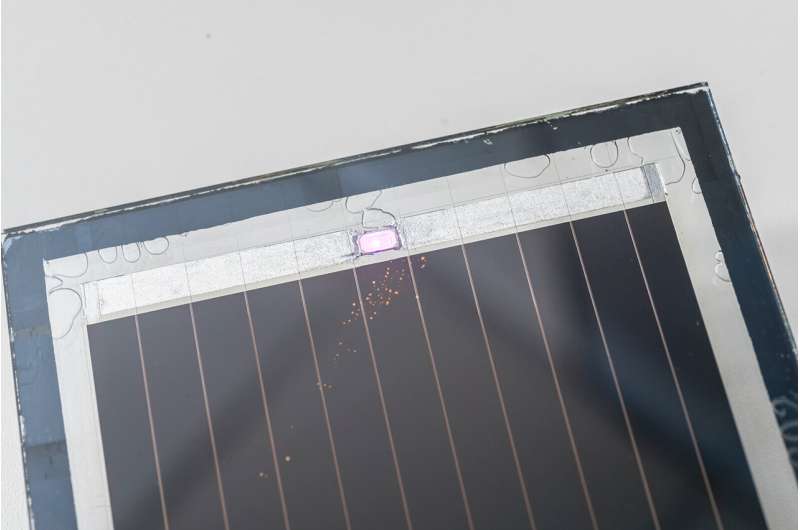This article has been reviewed according to Science X's editorial process and policies. Editors have highlighted the following attributes while ensuring the content's credibility:
fact-checked
peer-reviewed publication
trusted source
proofread
Highly efficient and stable solar cells can now be mass produced like printing newspapers

Scientists at the City University of Hong Kong (CityUHK) have developed highly efficient, printable and stable perovskite solar cells to achieve carbon neutrality and promote sustainable development.
The new type of perovskite solar cells can be mass-produced at a speed comparable to newspaper printing, with a daily output of up to 1,000 solar panels. Owing to their flexible, semi-transparent characteristics, they can also be made into light-absorbing glass windows, realizing the concept of "urban solar farms" in cities with many high-rise buildings.
The research is led by the Lee Shau Kee Chair Professor of Materials Science at CityUHK, Professor Alex Jen Kwan-yue, and the results were published in Nature Energy.
The team has demonstrated an effective strategy to enhance the long-term stability of perovskite-organic tandem solar cells. The integrated cells retain over 90% of their initial Power Conversion Efficiency (PCE) after 500 hours of operation.
The operational stability of wide-bandgap perovskites has been a challenge for scientists for over a decade. The CityUHK research team addressed the issue with creative material science solutions. The team designed a series of organic redox mediators with appropriate chemical potentials to selectively reduce iodine and oxidize metals.
After the perovskite device was integrated into the monolithic perovskite-organic tandem solar cell as a wide-bandgap subcell, the encapsulated tandem cell was subjected to 1-sun illumination (AM 1.5G spectrum, without a UV filter).
It retained 92% of its initial PCE after 500 hours of continuous operation at ∼45 °C. The team also reported record-high efficiency of 25.22% (certified 24.27%). The device also exhibited good operational stability in humid air (relative humidity, 70–80%).
Dr. Wu Shengfan, a key member of the research team and the first author of the paper, said, "We were the first team to propose the use of redox and chemical synthesis methods to fundamentally solve the problem, effectively ensuring the stability of perovskite solar cells."
He pointed out that CityUHK emphasizes critical thinking in nurturing doctoral students, mastering the most cutting-edge topics in the field, and understanding the biggest challenges faced and solutions to the most complex problems.
The research results will be transformed into practical applications through the start-up company HKTech Solar Limited, which will be managed by Dr. Francis Lin, a postdoctoral student of Professor Jen at CityUHK.
Perovskite photovoltaics can absorb energy even under weak indoor light and have mechanical flexibility. They can be integrated and applied in different scenarios, from large buildings and farms to various components of the Internet of Things.
The team also plans to set up a pilot production line with annual output of 25 megawatts in Hong Kong within a year and a half and launch products for industry matching investors to test applications.
More information: Shengfan Wu et al, Redox mediator-stabilized wide-bandgap perovskites for monolithic perovskite-organic tandem solar cells, Nature Energy (2024). DOI: 10.1038/s41560-024-01451-8
















